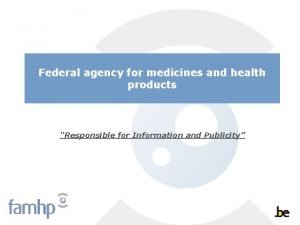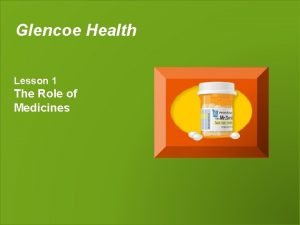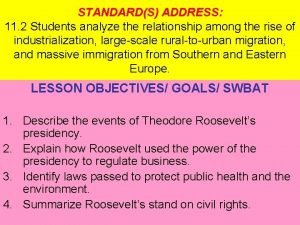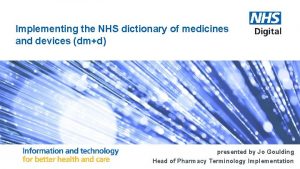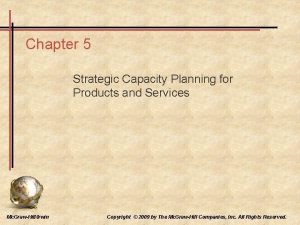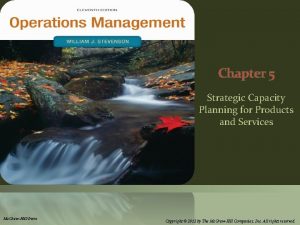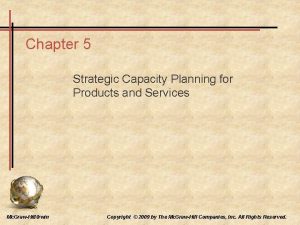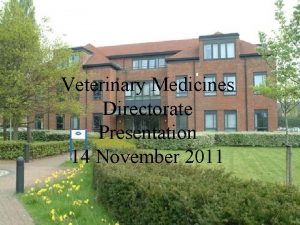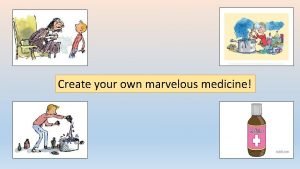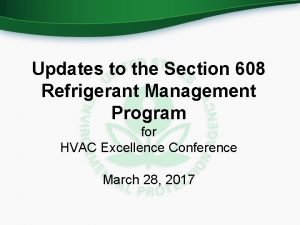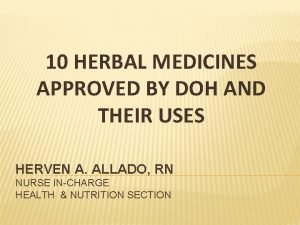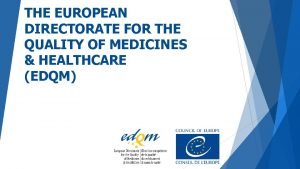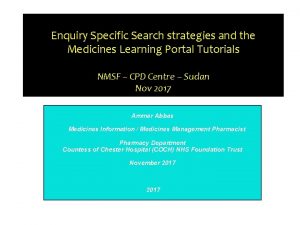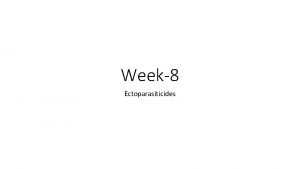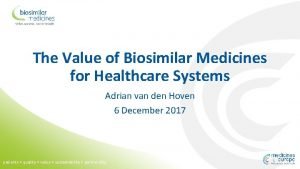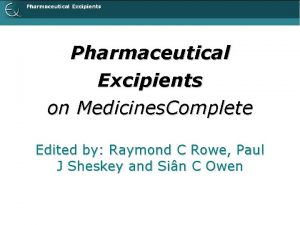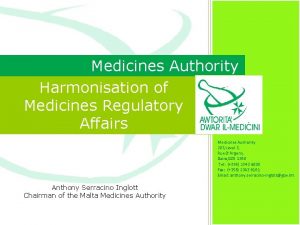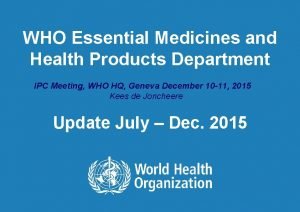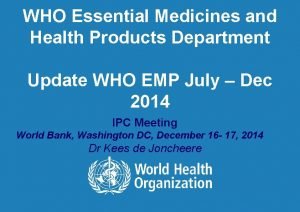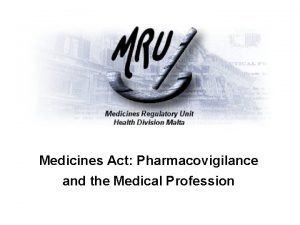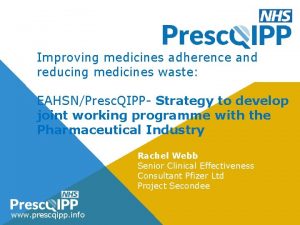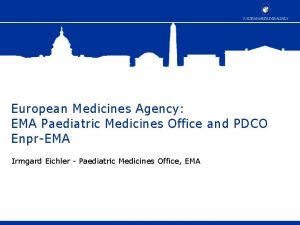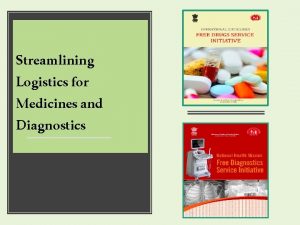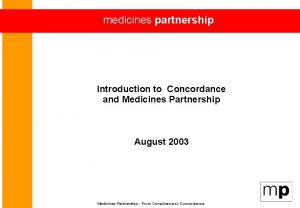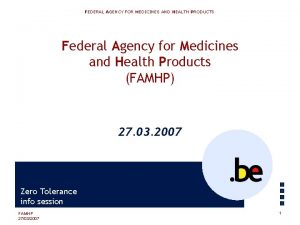WHO Essential Medicines and Health Products Strategic Plan



















- Slides: 19

WHO Essential Medicines and Health Products Strategic Plan Development – Feed-back from the WHA 67 th IPC Meeting WHO Geneva, June 04 - 06 1 | TITLE from VIEW and SLIDE MASTER | September 2020

WHO medicines & technologies 2014 -2019 strategy / action plan l GPW : 6 leadership priorities – Access to essential, quality-assured, affordable medical products l Three axis : – UHC : selection/HTA – financing/pricing – right supply mix – use – MDGs – NCDs l Underpinned by regulation to assure quality l Partnership l How : Standards + evidence/guidance + information/networking + country policy dialogue and support 2 | TITLE from VIEW and SLIDE MASTER | September 2020

Universal Health Coverage l Provide all people with access to needed health services (including prevention, promotion, treatment and rehabilitation) of sufficient quality to be effective; l Ensure that the use of these services does not expose the user to financial hardship“ 3 | TITLE from VIEW and SLIDE MASTER | September 2020

Universal Health Coverage l No country fully achieves all the coverage objectives - and harder for poorer countries l But all countries want to : – Reduce the gap between need and utilization – Improve quality – Improve financial protection l Thus, moving “towards Universal Coverage” is something that every country can do 4 | TITLE from VIEW and SLIDE MASTER | September 2020

UHC : what kinds of choices need to be made? Breadth, depth and scope of coverage; level and distribution of utilization, extent of catastrophic and impoverishing payments… 5 | TITLE from VIEW and SLIDE MASTER | September 2020

Providing Leadership innovative approaches for Appropriate financing & coordination of selection of R&D essential medicines for priority health & other health technologies 1 Affordable prices Management of intellectual property to enhance innovation in and access & monitor their trends Monitoring the health situation 6 | va o nn Facilitation in technology transfer & expansion in manufacturing capacity I & sustainable financing, procurement & supply mechanisms ce ss & us e Access to affordable, quality, safe medicines & health technologies 1 Safety monitoring & vigilance, & global safety issues monitoring, response & dissemination Providing technical support Ac n tio Shaping the research agenda Regulation Appropriate use & ethical promotion with sound policies & good governance Provision & promotion of quality, safety & efficacy norms and standards for priority health technologies Setting norms & standards 1 Prequalification services for priority health technologies 1 Technical assistance for regulatory systems strengthening, convergence & harmonization TITLE from VIEW and SLIDE MASTER | September 2020 Health technologies 1 include medicines, vaccines, medical devices, diagnostics and assistive technologies Articulating policy

Operationalizing across the 3 organizational levels EURO WPRO HQ (PHI, TSN, RSS, PQ, SAV, PAU) AMRO SEARO EMRO AFRO Countries 7 | TITLE from VIEW and SLIDE MASTER | September 2020

Feed-back from the WHA 67 th l Follow-up of the Report of the Consultative Expert Working Group on Research and Development: Financing and Coordination - Health R&D demonstration projects (DP) : - Firm go-ahead on the implementation of innovative health R&D DP selected in the run-up to the WHA. Through this decision the MS endorsed the indicators for measuring the success in implementing DP - WHO will take steps to establish at the Special Programme for Research and Training in Tropical Diseases (TDR) a pooled fund for voluntary contributions towards R&D for diseases of the poor. To be continued 8 | TITLE from VIEW and SLIDE MASTER | September 2020

Feed-back from the WHA 67 th l Resolution EB 134. R 16 Access to Essential Medicines: - Originally sponsored by China, adopted with small amendments. - WHO Essential Medicines List recognized as a valuable tool that enables countries to identify a core set of medicines which need to be accessible to provide quality medical care – with special mention of children. - This resolution provides us with a renewed mandate to continue to support MS in improving access in line with UHC, but also in connection with the MDGs and the NCD global action plan. It also provides us with the political umbrella to complete our strategic action plan for 2014 -19 9 | TITLE from VIEW and SLIDE MASTER | September 2020

Feed-back from the WHA 67 th l Resolution EB 134. R 17 on Regulatory System Strengthening for medical products: - Originally sponsored by USA, Mexico and Nigeria, and finally backed by EU, India, Brazil and other MS after a large range of amendments. - WHO important role globally in medicines regulation through establishing necessary norms and standards, supporting regulatory capacity-building, enhancing collaboration and networking among regulators, and strengthening safety monitoring programmes. - Endorses NRA assessment and PQ Programme for medicines/vaccines/ devices/Dx for selected priority essential medicines, diagnostics and vaccines. - Endorses the future progressive transition of prequalification to networks of strengthened NRA 10 | TITLE from VIEW and SLIDE MASTER | September 2020

Feed-back from the WHA 67 th l Resolution EB 134. R 14 Health Intervention and Technology Assessment in support of Universal Health Coverage : - Broad support for the Resolution (originally sponsored by Maldives and Myanmar): WHO will support capacity-building for Health Technology Assessment in countries. - WHO will provide tools and guidance to prioritize health technologies and intensify networking and information exchange among countries to support priority setting. 11 | TITLE from VIEW and SLIDE MASTER | September 2020

Considerations in priority setting l In moving towards UHC, questions focus on: – The population covered by the package of interventions: Who is covered? – The services that can be provided: Which services? – The proportion of service costs that can be covered: How much? l Health technology assessment (HITA) is an important process to aid priority-setting within the services axis of the UHC cube 12 | TITLE from VIEW and SLIDE MASTER | September 2020

The continuum of H(I)TA activities Health Systems Fragile states: Essential services Emergency kits Disaster planning Low income countries with low coverage, Primary health care packages Continuum of HTA Activities 13 | TITLE from VIEW and SLIDE MASTER | September 2020 Middle income countries with low coverage, Guaranteed packages of care Strong health system, Marginal analysis for additions to packages

Feed-back from the WHA 67 th l Resolution EB 134. R 19 on Access to biotherapeutic products and ensuring quality, safety and efficacy : - Resolution (originally put forward by Argentina and UNASUL ) to improve access to biotherapeutic products, including similar biotherapeutic products, was approved. - Many issues to be discussed still on the technical regulatory aspects but it was noted that pre-ICDRA meeting in August on biotherapeutics would help to shed light on this evolving area. - Resolution calls for developing the necessary scientific expertise to facilitate development of scientifically-based regulatory frameworks that would promote the access to biotherapeutic products that are affordable, safe, efficacious and of quality. WHO has been requested through the Expert Committee on Biological standardization to update the 2009 guidelines on similar biotherapeutic products 14 | TITLE from VIEW and SLIDE MASTER | September 2020

Feed-back from the WHA 67 th l Resolution EB 134. R 13 on Combating Antimicrobial resistance, including antibiotic resistance: - Originally submitted by UK and Sweden. Set to create the momentum to tackle the growing threat of AMR. WHO will develop a global action plan to combat antimicrobial resistance for approval in WHA 2015. - Global action plan : multisectoral approach - MS and multilateral stakeholders. - Responsible use of antibiotics, surveillance of consumption, regulation aspects on products approval and on prescribing and dispensing, use of antibiotics in veterinary medicines, and new models for antibiotic innovation will all need to be covered in the global action plan. 15 | TITLE from VIEW and SLIDE MASTER | September 2020

Feed-back from the WHA 67 th l Resolution EB 134. R 18 on Hepatitis : - Resolution (originally put forward by Brazil) approved to improve the prevention, diagnosis and treatment of viral hepatitis. - Importance of implementing appropriate measures to protect groups such as people who inject drugs from infection and to improve their access to diagnostics and treatment, whilst addressing intellectual property rights issues related to those products. - The Resolution mandates WHO to lead a discussion on access to new therapies, very timely as the new Hep C drugs are prohibitively expensive even for High income countries , and tiered pricing arrangements are too restrictive. 16 | TITLE from VIEW and SLIDE MASTER | September 2020

Feed-back from the WHA 67 th l Resolution EB 134. R 7 on Strengthening of palliative care as a component of integrated treatment within the continuum of care : - First ever Resolution on palliative care, originally sponsored by Panama and Chile, emphasizes the importance of palliative care services, as a component of UHC and integrated treatment and service delivery, as well as in connection with NCDs and TB and HIV/AIDS; - The resolution has specific paragraphs on improving access to controlled medicines for pain and palliative care, including for the children, and as such provides impetus to this specific area of the ”access” agenda. 17 | TITLE from VIEW and SLIDE MASTER | September 2020

Feed-back from the WHA 67 th l SSFFC Mechanism (counterfeiting): - The WHA noted the report of the MS mechanism meeting in November 2013 and stressed the importance of SSFFC; - Concern was expressed over the continued lack of funds. In line with the MS Mechanism decision on rotation of the Chair, it was announced that Argentina will assume the Chair of the Steering Committee of the MSM, with immediate effect. 18 | TITLE from VIEW and SLIDE MASTER | September 2020

Feed-back from the WHA 67 th l Resolution on Health in the post-2015 development agenda: - The Resolution has been approved and calls for a health goal that includes UHC and a continued focus on priority disease areas (the unfinished work of the health Millennium Development Goals), a focus on non-communicable diseases (NCD), mental health - The resolution stresses the importance of universal health coverage (UHC) and the need to strengthen health systems. This is very much in line with the approaches WHO/EMP has taken in drafting the Strategic action plan for 2014 -2019. 19 | TITLE from VIEW and SLIDE MASTER | September 2020
 Federal agency for medicines and health products
Federal agency for medicines and health products Chapter 19 medicines and drugs vocabulary practice
Chapter 19 medicines and drugs vocabulary practice Which legislation helped solve trusts
Which legislation helped solve trusts Nhs dictionary of medicines and devices
Nhs dictionary of medicines and devices Characteristics of lipids
Characteristics of lipids Functional products examples
Functional products examples Strategic capacity planning for products and services
Strategic capacity planning for products and services Strategic capacity planning for products and services
Strategic capacity planning for products and services Strategic capacity planning for products and services
Strategic capacity planning for products and services Strategic capacity planning for products and services
Strategic capacity planning for products and services Veterinary medicines directorate
Veterinary medicines directorate Staff of marvelous medicines
Staff of marvelous medicines Medicines management programme
Medicines management programme Apollo hospital is
Apollo hospital is Niyog niyogan uses and preparation
Niyog niyogan uses and preparation European directorate for the quality of medicines
European directorate for the quality of medicines Medicines learning portal
Medicines learning portal Ectoparasiticides veterinary medicines
Ectoparasiticides veterinary medicines Abasagar
Abasagar Medicines complete
Medicines complete
